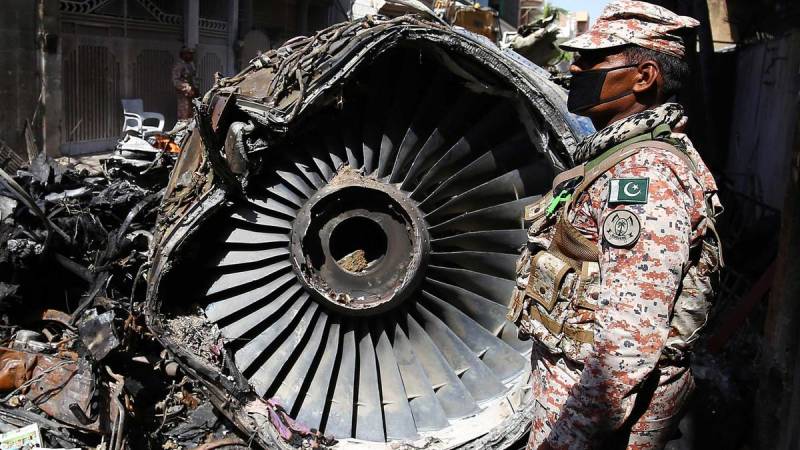PIA ‘closer to bankruptcy’ following crash and pandemic
Airline now has current liabilities of $2 billion, more than six times the value of its assets

Stay tuned with 24 News HD Android App

A deadly Pakistan International Airlines (PIA) crash that killed 97 people in May has put a plan to revive the airline, which has more accumulated losses than any other publicly-traded carrier in Asia, in jeopardy, reported Bloomberg.
The state-run PIA had just posted its first gross profit in eight years, was starting to fly again after a two-month nationwide lockdown, was on the verge of reviving a direct route to the US, and had proposed revival plans to the government. But the Airbus SE A320 jet crash into a residential neighbourhood in Karachi has reignited questions about its viability.
“It’s possible that PIA becomes the last choice for travellers,” said Khurram Schehzad, chief executive at Karachi-based advisory Alpha Beta Core Solutions. “The public sector airline has a bad reputation with timing and service in the past, and this would impact the airlines business even more. Many people would be inclined to fly competition, for now.”
The malaise at the airline stems from frequent labour strife, changes in leadership -- the airline has had six chief executives in five years -- and red tape. That, in turn, has added to the woes of the carrier, which last reported a net income a decade and a half ago, and has suffered 52 safety-related incidents in the 54 years of its existence, according to data from Aviation Safety Network.
“Air travel works on dependability and trust of passengers on your service. People are too safety-conscious when it comes to air travel,” PIA spokesman Abdullah Hafeez Khan said by phone. “It will take a lot of time to recover.”
PIA, and Pakistan’s aviation sector in general, is managed by either generalist bureaucrats, or military officers, or a combination of the two, according to Mosharraf Zaidi, a senior fellow at Islamabad-based think tank, Tabadlab.
PIA had accumulated $3 billion of losses as of last year, hurting its ability to take on rivals. Apart from middle-eastern heavyweights such as Emirates Airline and Etihad Airways, the ailing carrier also faces new local competition in Airblue, emerging carrier SereneAir and upcoming AirSial, and is losing market share in the process.
“A disproportionate number of plane crashes is part of a wider malaise,” said Zaidi. “Without a wider commitment to excellence, to professionalism and to an economic transformation, no one should expect any major changes or improvements.”
PIA’s current chief executive, Arshad Mahmood Malik, is a vice chief of air staff at the air force.
The misery of former Deutsche Lufthansa executive Bernd Hildenbrand is a case in point. After Hildenbrand joined as the airline’s first foreign chief executive, his salary was immediately leaked to the press. Months later, he was stopped from leaving the country, citing an investigation into a plane-lease contract. Another chief executive was locked into the bathroom by union members, according to the local media.
Even Malik, the current chief executive, was suspended for a few months this year by the Supreme Court following a petition by a labour union leader. He was allowed to resume work only after the state lawyer said Prime Minister Imran Khan believes Malik was indeed the right man to manage the carrier “on ventilator.”
The latest crash -- the worst for PIA since 1992 in terms of fatalities -- comes as demand has been destroyed with countries imposing travel restrictions to check the spread of the coronavirus. The industry is staring at a $314 billion loss in ticket sales this year, with 70 percent of global capacity idled, according to the International Air Transport Association.
PIA shares, which have fallen almost 37 percent this year, closed 1.7 percent down at 4.21 Pakistani rupees on Thursday. The market value of the airline has slumped to $136 million.
PIA, which owns the iconic Roosevelt Hotel in Manhattan, is the most likely airline in the world to go bankrupt, according to a Bloomberg News analysis. Airline officials in March presented multiple bailout options to the government, as losses and debt have become too much for the company to handle alone. The airline offered to transfer some debt to the government, conduct a debt-to-equity swap or to issue a long-term bond.
PIA, which along with neighbouring counterpart Air India once stood for the emergence of two infant South Asian nations on the world stage following independence from the British in 1947, now has current liabilities of $2 billion -- more than six times the value of its assets. The airline can’t survive without more taxpayer-funded bailouts.
